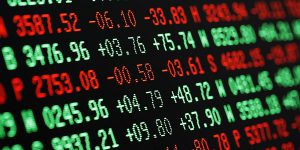An investment is the acquisition of an asset such as a stock or bond where the reasons for parting with your money are more compelling than the alternatives. Your portfolio is an accumulation of assets owned and designed to transfer your purchasing power to the future. The sum of income plus capital gains earned by your investments while keeping risk confined to a tolerable range is your reward.
The two most important risks in investing are systematic risk which is associated with market-wide fluctuation in security prices and unsystematic risk which is risk associated with individual events affecting a particular security. Other forms of risk are business risk, financial risk, market risk, interest rate risk, reinvestment rate risk, purchasing power risk and exchange rate risk.
An efficient financial market implies a security’s price embodies all known information concerning the potential return and risk associated with the particular asset. Visit our Introduction to Investments page to get a more detailed introduction to the basics.
This page gives an overview of investing. For a more in depth discussion of each topic, click the link at the end of each section.
Security Markets
Firms acquire funds by issuing new securities and selling them to the general public. An investment bank serves as a middleman to channel money from investors to firms who need capital.
Securities are bought and sold every day on either an organized exchange or the informal over-the-counter market through market makers. Market makers quote an equilibrium price which equates the supply with the demand for the security.

You can purchase stocks and bonds through brokers. Once the shares have been purchased and paid for, you take delivery electronically from your broker who also acts as your custodian.
The security industry is subject to a substantial degree of regulation both from federal and state governments. Their purpose is to protect you by ensuring honest and fair practices and providing full disclosure. To learn more about securities markets, visit our Security Markets page.
Information Sources
Publicly held firms are required by both federal and state laws, to publish annual and quarterly reports. The annual report is most important and contains a letter to shareholders and financial statements including a balance sheet, income statement and statement of cash flows.
One service some brokers offer is research on specific securities. The purpose is to identify undervalued securities with the potential for price appreciation. However, analyst recommendations should not necessarily be take at face value, due to institutional biases.
The foremost financial newspaper is the daily Wall Street Journal. Barron’s is published weekly reporting various articles of interest to the investment community and issuing investment advisory reports . A variety of magazines also report financial news, ranging from Money and Business Week to Forbes and Fortune. More academically and professionally oriented magazines include Journal of Finance, Harvard Business Review, Journal of Portfolio Management and Financial Analysts Journal.
The US government publishes a considerable amount of information helpful to investors. These publications include Survey of Current Business, Business Conditions Digest, Economic Report of the President, Annual Report of the Council of Economic Advisers and Federal Reserve Bulletin. To learn more about information sources visit our Information Sources page.
Risk and Portfolio Theory
The time value of money is one of the most crucial concepts in finance. It is the notion a dollar received in the future is worth less than a dollar in hand today. Cash flows occurring in different periods must be adjusted to their value at a common point in time to be analyzed and compared.
The purpose of portfolio management is to determine the combination of risk and return which allows the investor the highest return for a given level of risk. Risk is concerned with the uncertainty the realized return will not equal the expected return.
The measurement of risk places emphasis either on the extent to which the return varies from the average return or on the volatility of the return relative to the return on the market. Variability is measured by standard deviation while the volatility is measured by beta.
A portfolio might have achieved diversification in the past because the individual security returns were not highly correlated, but this may not be so in the future. Harry Markowitz in 1959 developed a model on which an risk-averse investor can construct a diversified portfolio which maximizes their satisfaction by maximizing portfolio returns for a given risk level.
The CAPM model gives us a precise prediction of the relationship we should observe between the risk of an asset and its expected return. Risk is measured by the portfolio’s standard deviation while the individual asset’s risk is measured by a beta coefficient.
As long as there is a strong relationship between the return on a stock and the return on the market, the beta has meaning. The greater the beta, the more systemic risk is associated with the individual stock. To learn more about risk and portfolio theory, visit our Risk and Portfolio Theory page.
Investment Companies
The rationale for investment companies is simple and appealing. They have the advantages of professional management, benefit of ownership in a diversified portfolio, potential savings in commissions and custodial services.
Closed end funds have characteristics similar to stocks and bonds traded in the security markets. Because of the limited number of shares, you have to buy the shares of an existing holder. Open ended funds or mutual funds (MFs) are similar to closed ended ones except they don’t trade on a secondary exchange, trade exactly at net asset value and have additional fees such as front/ back-end loads,and management and marketing fees.
The newest type, exchange traded funds (ETFs), are similar to MFs. Instead of buying the shares from the company, you purchase them on exchanges. This ability gives you flexibility to buy and sell throughout the day rather than only buying at the MF closing price.
Professional management is no guarantee the funds will outperform the market. In fact, many studies show their performance was not significantly different than an unmanaged portfolio of similar assets.
Individual investors experience a different return than the fund’s reported return due taxation and fees. The MF’s and ETF’s reported returns are before taxes and load charges. To learn more about investment companies, visit our Investment Companies page.
Stock Valuation
Because stock represents ownership, investors who purchase shares obtain all the rights of ownership including the right to vote the shares. But democracy in corporations doesn’t work well. Since a shareholder has limited influence, the rule of thumb and SCM’s policy is ‘vote with your feet’ (sell), if you don’t like what you see.
As with any asset, valuation involves bringing future cash flows back to the present at the appropriate discount rate. This discount rate is the required return you demand to justify buying the stock. Your required return has two components: the risk-free rate and a risk premium.
The dividend discount model is a formula to estimate the intrinsic value of a firm by figuring the present value of all future dividends. Alternatively, PE ratios (price/earnings) are analyzed using actual earnings or estimated earnings. The metrics are compared to the stock’s historic ranges and industry/market averages.
The efficient market hypothesis suggests investors cannot expect to outperform the market consistently on a risk-adjusted basis. The term random walk means price changes are unpredictable and patterns formed are accidental. Since the markets digest information efficiently, it is the unpredictability of new information being revealed which causes the randomness. To learn more about stock valuation, visit our Stock Valuation page.
Macroeconomic Environment
Financial analysis has a logical progression from general to specific. First, the analyst considers the economic environment which may give a hint on where stock prices are headed. Then, the analyst considers the industry since industries react differently to changes in the economy. At the individual stock level, what’s happening at the macro-economic level may not apply.
The business cycle is an economic pattern of expansion and contraction averaging three to ten years. GDP measures the total value of transactions in a business cycle. A recession is a period of rising unemployment and declining GDP where the economy doesn’t grow for two consecutive quarters.
 The Federal Reserve has a large influence on the economy through its monetary policy. Their objectives to stabilize general price levels and ensure full employment. When the Fed drains money out of the system and tightens credit, the cost of capital and earnings capacity is adverse.
The Federal Reserve has a large influence on the economy through its monetary policy. Their objectives to stabilize general price levels and ensure full employment. When the Fed drains money out of the system and tightens credit, the cost of capital and earnings capacity is adverse.
Industries go through life cycles much like animals, sometimes independent of the economy. A new innovation might spawn an industry, attracting new players and making it more competitive. The timing of these life cycles can be very short or there can be many barriers to entry which can extend the health of the cycle.
Though the linkage between the economy and share prices is complex, forming an opinion about the future economic environment is essential. Areas of focus include interest rates, inflation, employment and economic growth. To learn more about analyzing the macroeconomic environment, visit our Macroeconomic Environment page.
Statement Analysis
Financial statement ratios are probably the most frequently used tool to analyze a company because they are readily understood and can be computed with ease. The ratios are used to perceive trends in a time series of an individual firm or comparing peers in cross sectional analysis.
Liquidity is the ease a firm converts their assets to cash. A highly liquid firm pays their bills without loss. The liquidity ratios are useful to creditors who are concerned with getting paid on a timely basis.
Activity ratios indicate the rate a firm is turns its inventory and accounts receivable into cash. High turnover signals the firm is in better position to handle liabilities, but does not indicate it’s maximizing profitability.
The amount a firm earns is most important to investors. Earnings accrue to shareholders and fuel dividends. Profitability ratios measure earnings relative to a base such as sales, assets or equity.
Financial leverage, measured by debt ratios, indicate how the firm can magnify the shareholder’s investment. Because debt financing can have such an impact on the firm, these ratios are extremely valuable in analyzing the financial position.
An investor does not need a ton of ratios to get a good idea of a firm’s financial condition. Performance metrics are more relevant to investors with measures such as distribution of earnings, growth in earnings and market’s valuation of the stock.
There can be variations in ratios from year to year or things can remain stable. If there are deviations from benchmarks or from peers, the investor must ask why. Even if past performance is repeated, the investor needs to have an idea of the firm’s worth. To learn more about statement analysis, visit our Statement Analysis page.
Bond Market
A bond is a security issued by a borrower which obligates the issuer to make specified payments to the holder over a specific period. A coupon bond obligates the issuer to make interest payments called coupon payments over the life of the bond, then to repay the principal at maturity.
The bond market market is about a third larger than the stock market. Bonds are purchased like stocks, either from a broker/dealer or on an exchange.The price of any bond is primarily related to the interest paid by the bond, the interest rate investors may receive on comparable competitive bonds and the maturity date.
Governments at all levels issue bonds to cover the shortfall from tax receipts and expenditures. Corporations issue many types of bonds, either secured or unsecured. Legally, preferred stock is considered an equity but due to its fixed payout nature it has the characteristics of a bond.
Computing yield to maturity is used to compare bonds but doesn’t work when bonds have different maturities and coupons. An alternate technique, duration, compares bonds with varying maturities and coupons by determining each bond’s sensitivity to interest rate changes.
Since bonds pay a fixed income and mature at a specified date, they are conducive to passive management. The market value of the portfolio fluctuates but the investor is assured of a specified return of principal if the issues are held to maturity. To learn more about bond markets, visit our Bond Market page.
Foreign Securities
The value of global market is currently $69 trillion with 60% of it traded on exchanges outside North America. The growth of Europe and Asia suggests the US market is becoming a declining part of the total.
US residents invest in foreign securities to earn a return through receipt of income, price appreciation and currency exchange fluctuation. Political risk and local taxation must be considered in the investment decision.
 There would be little risk associated with currency price fluctuations if the prices of currencies were stable, but this is not the case. Investors can reduce the risk of loss by hedging with derivatives, such as futures contracts.
There would be little risk associated with currency price fluctuations if the prices of currencies were stable, but this is not the case. Investors can reduce the risk of loss by hedging with derivatives, such as futures contracts.
In the case of foreign investments, capital gains occur because the value of the asset rises or the value of the currency in which the asset is denominated, rises. The value of currencies responds to changes in demand and supply for the currencies.
The most obvious advantage of investing in foreign investments is investing in economies and firms experiencing economic growth. While growth is not unique to foreign markets, there are two other advantages– market inefficiency and diversification.
The basic types of mutual funds and ETFs which invest in foreign securities are:
- Global funds, which invest in foreign and US securities
- International funds, which only invest in foreign securities
- Regional funds specialize in a particular geographical area
- Emerging funds specialize in securities located in less-developed nations.
For a more in-depth look at foreign securities visit our Foreign Securities page.
Visit these topics for further detail:
- Basics Introduction
- Security Markets
- Information Sources
- Risk and Portfolio Theory
- Investment Companies
- Stock Valuation
- Macroeconomic Environment
- Statement Analysis
- Bond Market
- Foreign Securities
The material presented on this page and Investment Basics pages were adapted from Dave’s lecture notes for the Investments for Professionals course taught at UCLA 1998-2005 and three decades of practical experience. See our Site Credits page for reference sources.


